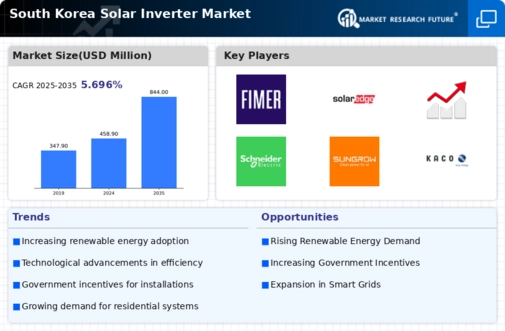Supportive Regulatory Framework
A supportive regulatory framework is crucial for the growth of the solar inverter market. In South Korea, policies promoting renewable energy adoption, such as feed-in tariffs and renewable portfolio standards, have created a conducive environment for solar investments. The government has set ambitious targets for solar capacity, aiming for 63 GW by 2030. This regulatory support not only encourages the installation of solar systems but also drives the demand for high-quality inverters that can efficiently manage energy production. As regulations continue to evolve, the solar inverter market is likely to benefit from increased installations and a focus on compliance with energy standards, further enhancing market dynamics.
Rising Demand for Renewable Energy
The increasing demand for renewable energy sources in South Korea is a pivotal driver for the solar inverter market. As the nation aims to reduce its carbon footprint, the transition towards solar energy has gained momentum. In 2025, renewable energy is expected to account for approximately 20% of the total energy mix, with solar energy being a significant contributor. This shift is likely to propel the solar inverter market, as efficient inverters are essential for converting solar energy into usable electricity. The government's commitment to achieving a 30% share of renewables by 2030 further underscores the potential growth in this sector. Consequently, the solar inverter market is expected to expand as more residential and commercial installations emerge, necessitating advanced inverter technologies to optimize energy conversion and management.
Increased Focus on Energy Independence
An increased focus on energy independence is driving the solar inverter market in South Korea. The nation has been actively seeking to reduce its reliance on imported fossil fuels, which has led to a strategic pivot towards renewable energy sources. In 2025, the government aims to achieve a 20% reduction in energy imports by enhancing domestic energy production capabilities. This initiative is likely to boost the solar inverter market, as more households and businesses invest in solar energy systems to contribute to national energy goals. The emphasis on self-sufficiency in energy production supports the growth of the solar inverter market. It also aligns with broader sustainability objectives.
Growing Investment in Solar Infrastructure
Growing investment in solar infrastructure is a significant driver for the solar inverter market. In South Korea, substantial financial commitments from both public and private sectors are being directed towards solar energy projects. In 2025, investments in solar infrastructure are projected to exceed $10 billion, reflecting a robust commitment to expanding solar capacity. This influx of capital is likely to stimulate demand for solar inverters, as new installations require advanced inverter technologies to ensure optimal performance. Furthermore, as the market matures, the emphasis on upgrading existing systems will also contribute to the growth of the solar inverter market, as older inverters are replaced with more efficient models.
Technological Innovations in Inverter Design
Technological innovations in inverter design are transforming the solar inverter market. The introduction of smart inverters, which offer enhanced functionalities such as grid support and real-time monitoring, is particularly noteworthy. These advancements not only improve energy efficiency but also facilitate better integration with smart grid systems. In 2025, it is estimated that smart inverters will represent over 50% of the total inverter sales in South Korea. This trend indicates a shift towards more sophisticated solutions that can adapt to varying energy demands and grid conditions. As the market evolves, manufacturers are likely to invest in research and development to create more efficient and reliable inverter technologies, thereby driving growth in the solar inverter market.




















Leave a Comment